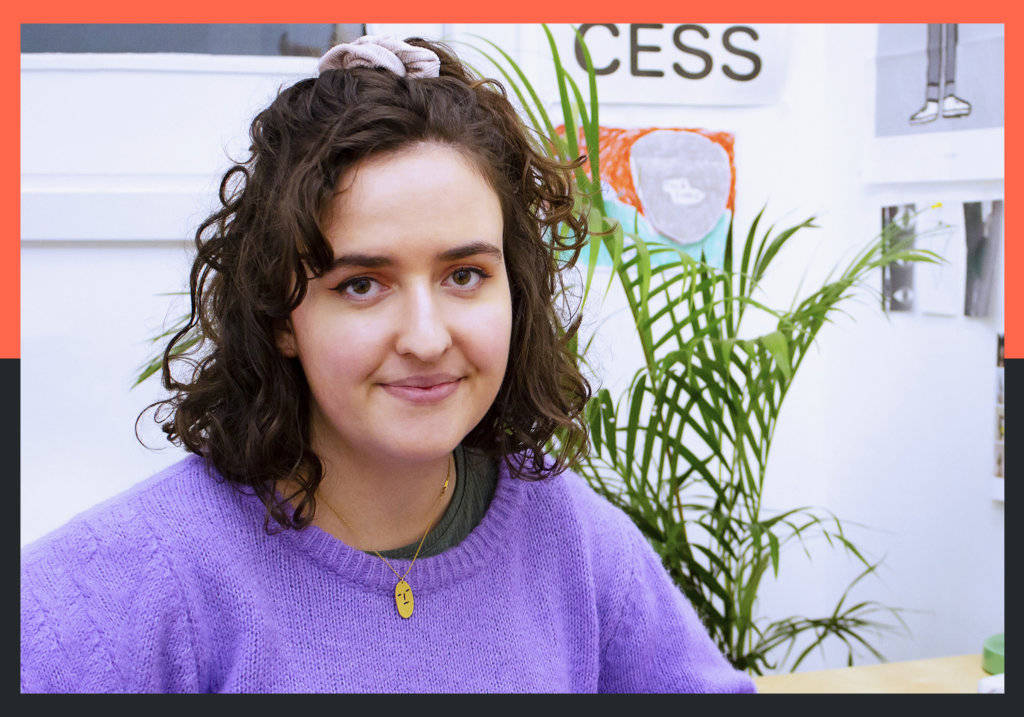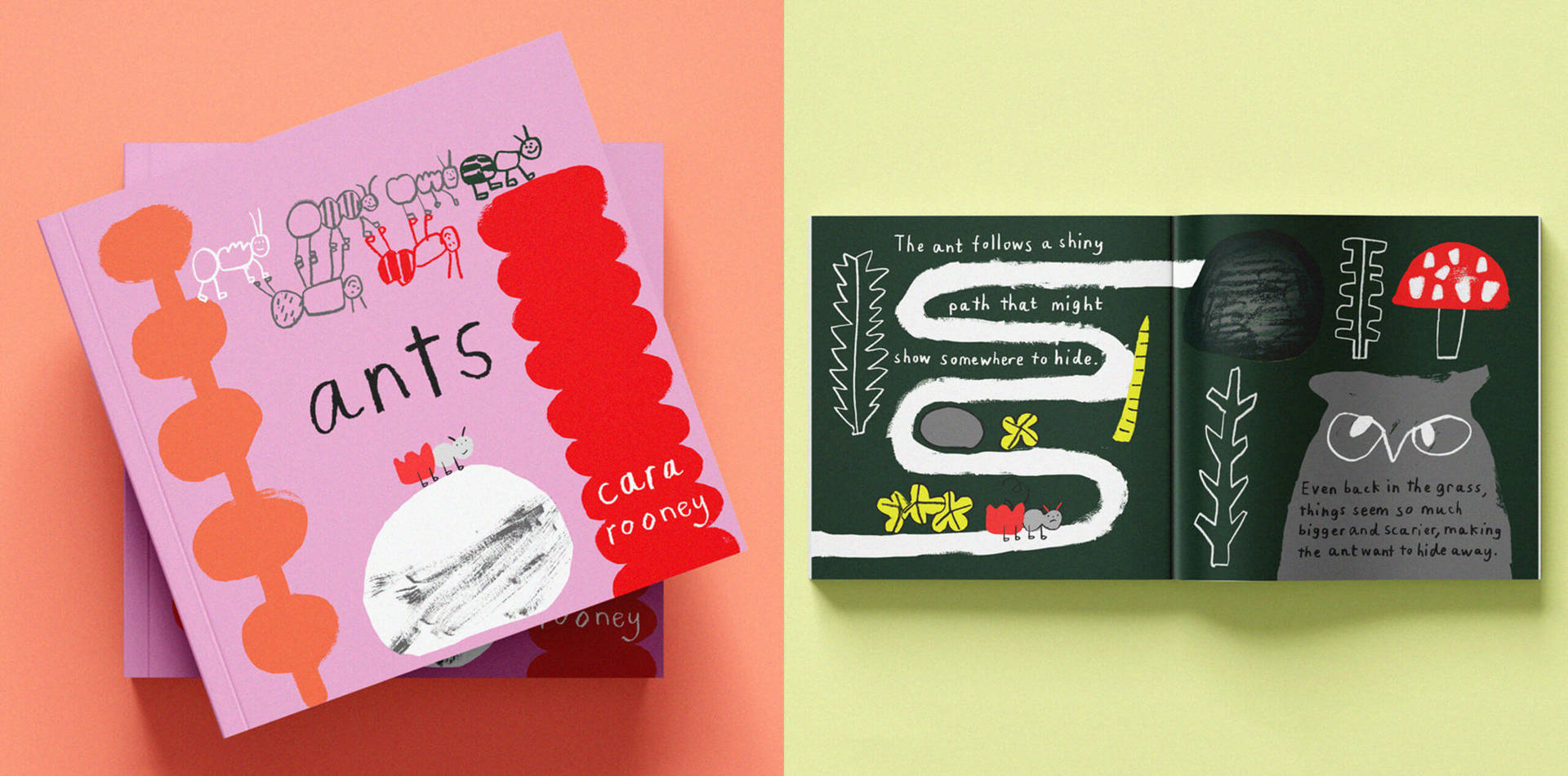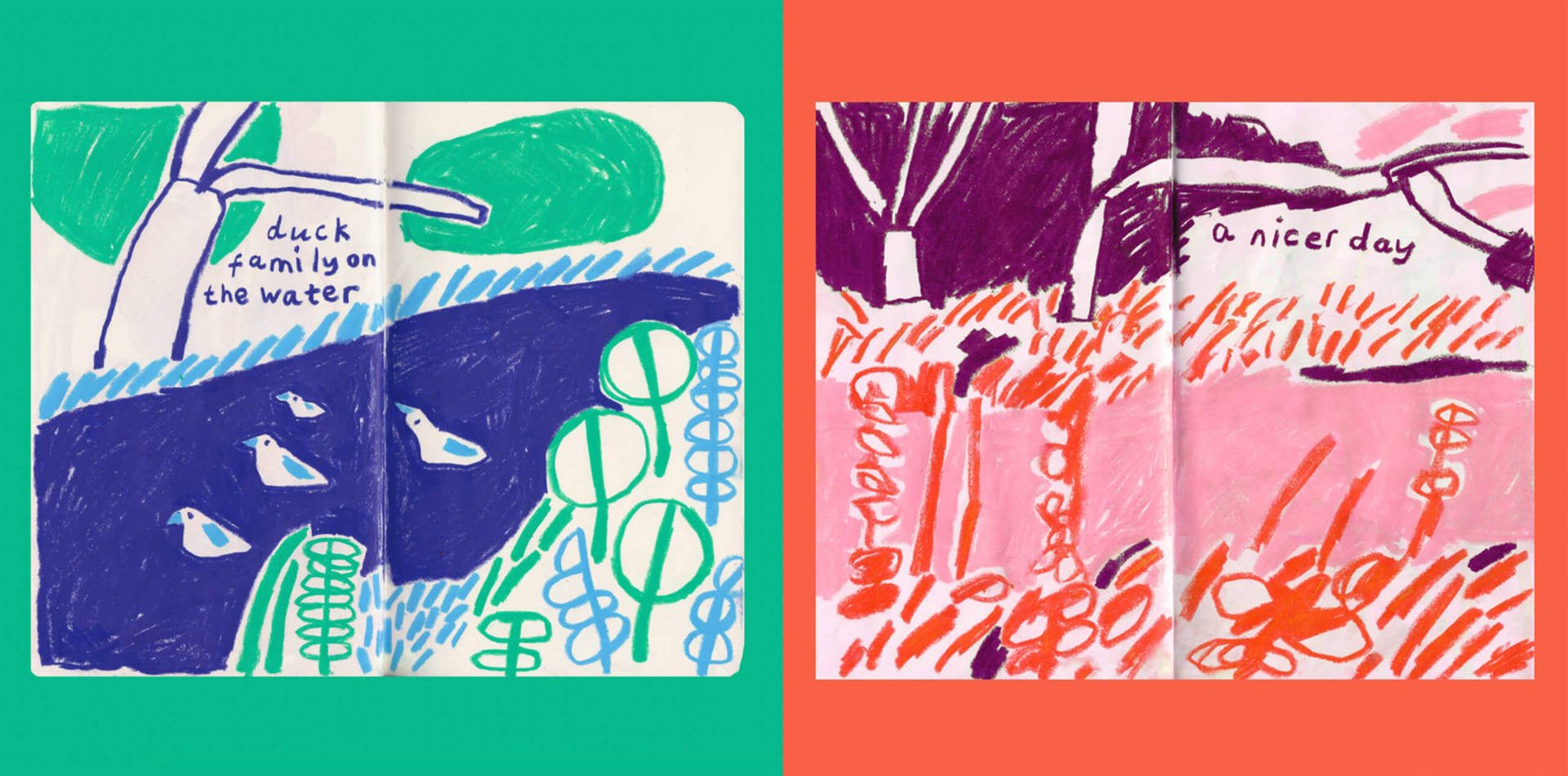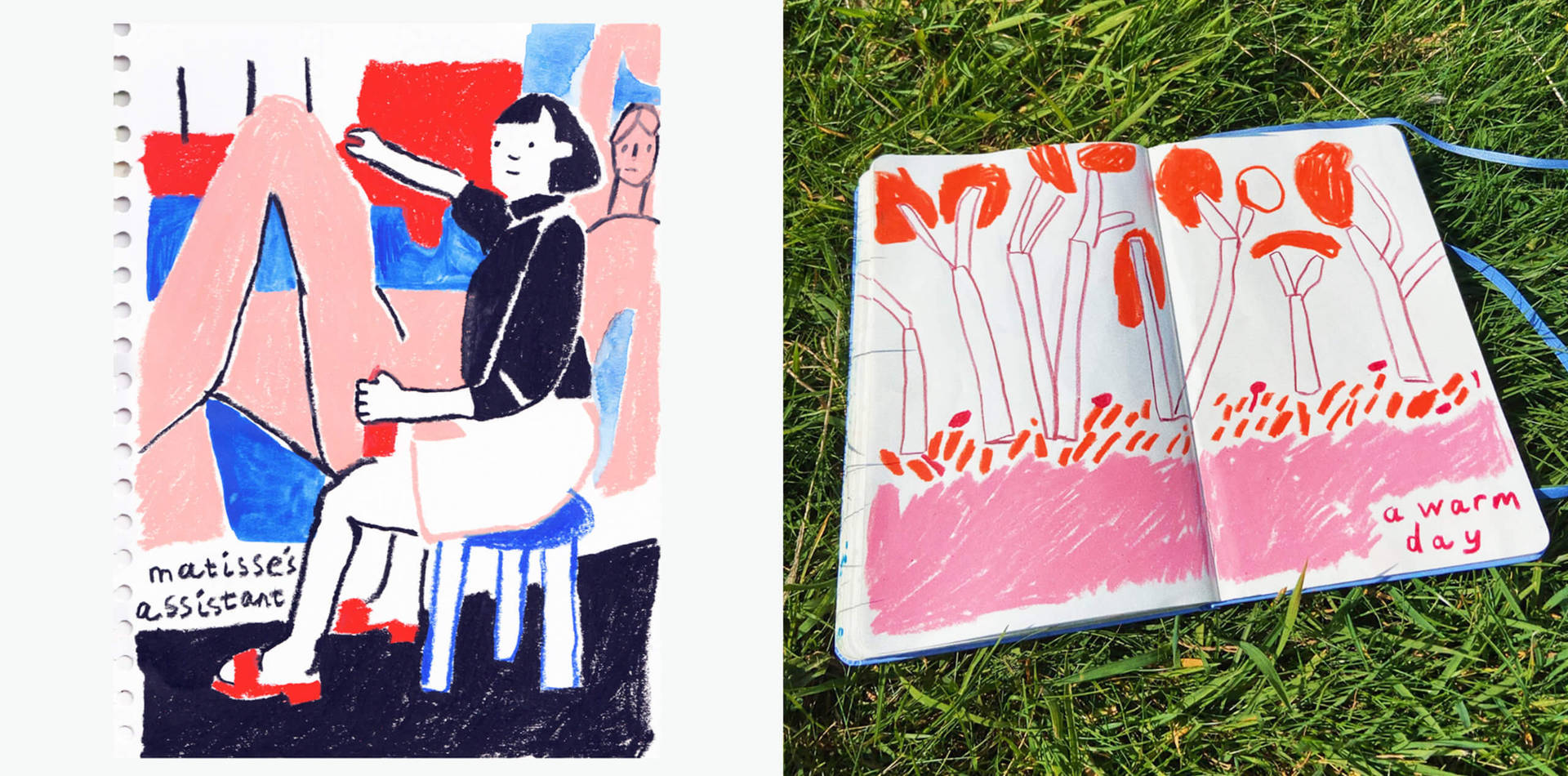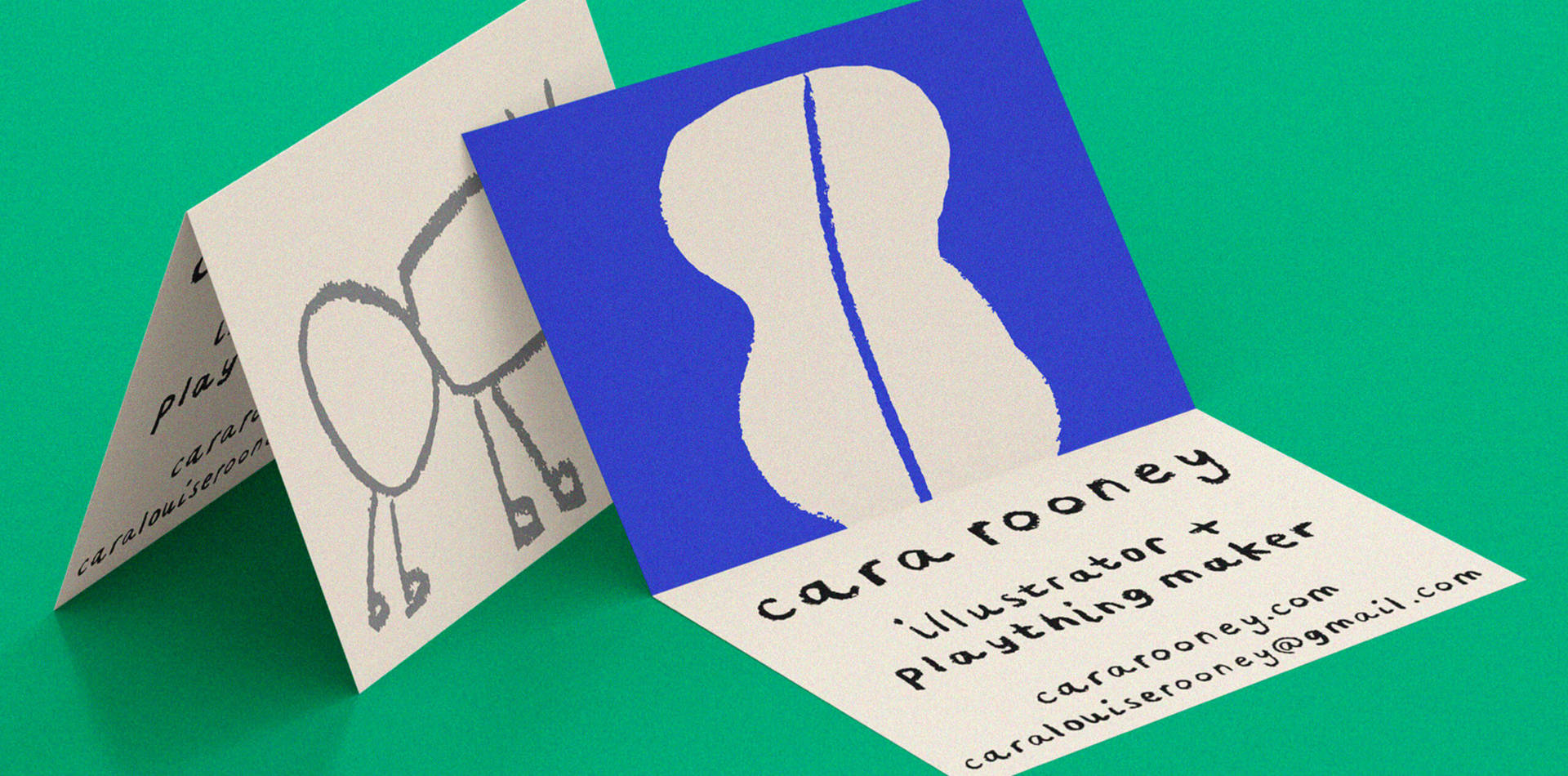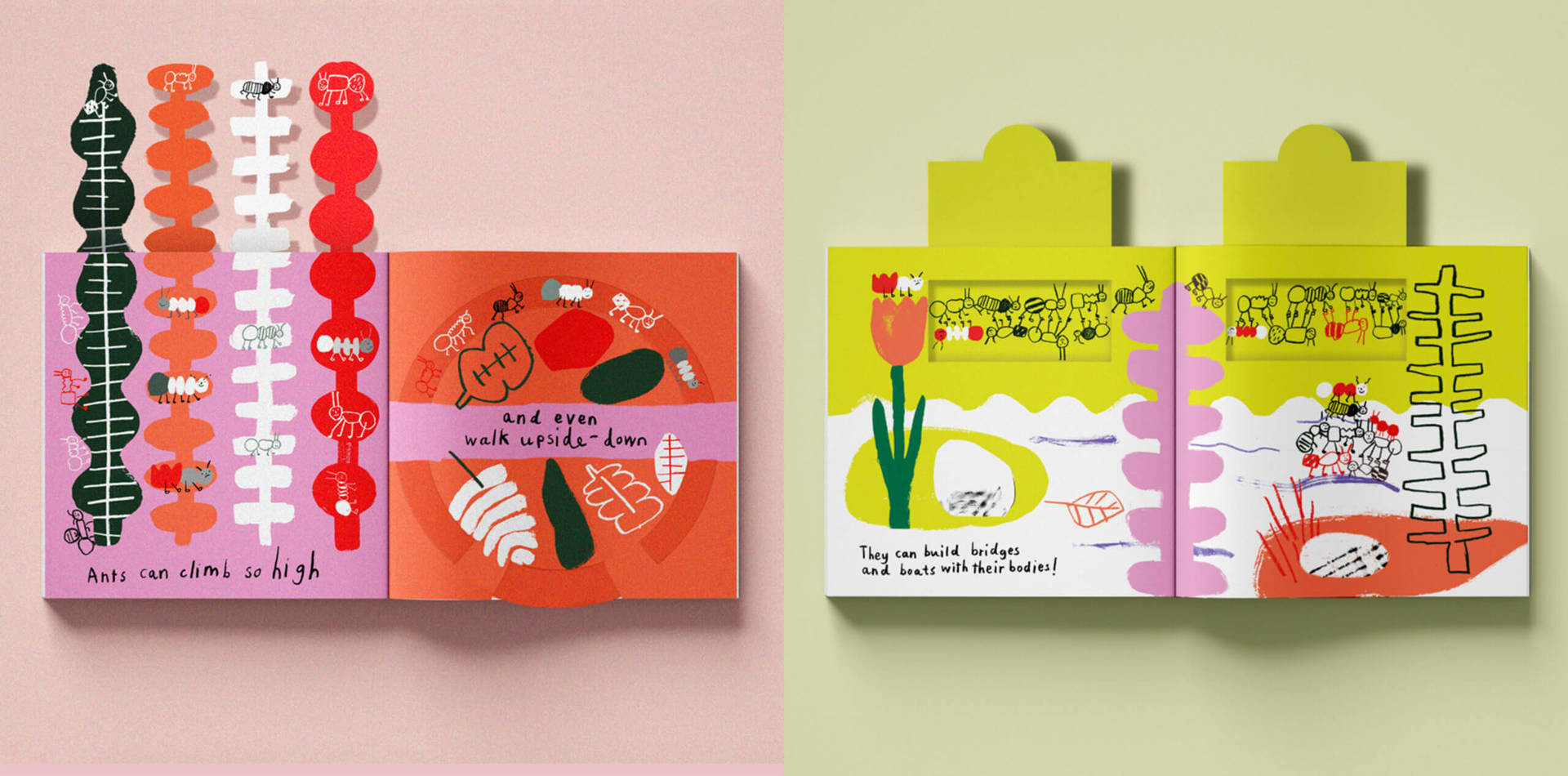2020 graduate of Duncan of Jordanstone College of Art and Design, Cara Rooney has burst onto the creative scene with her distinctive, playful and interactive illustration style. Nature, child-like curiosity and storytelling are at the centre of Cara’s visual language and her award-winning work has led to a recent feature on creative platform It’s Nice That and being awarded funding by Creative Scotland for tutorials with Orange Beak Studio.
During her childhood, Cara spent most of her time drawing, reading and writing stories. Encouraged from an early age to keep a diary, this eventually evolved into regularly keeping sketchbooks. A natural gravitation towards art, design and English continued throughout school and led to Cara’s love for illustration, which she sees as midway point between all her interests. Throughout her degree, she made the most of experimenting with a diverse range of illustration applications from editorial and book illustration to set design. Always looking for ways to make project outcomes both ‘playful’ and ‘surprising’, she tells us, ‘I think that was one of the best parts of studying illustration – the freedom to play and experiment with lots of different mediums and ways of communicating ideas.’
It was the birth of her younger brother and sister, halfway through her degree, that sparked Cara’s particular interest in children’s books and creating for children: ‘I remembered how inspiring young minds are and their innate curiosity for everything.’ Since then, she has often taken inspiration from her siblings and during her final year at university explored creating eco-friendly toys that would allow children to develop a passion for nature. She produced the amazing picture book ‘Ants’ – about the importance of tiny critters and how productive they are when they work together – the project showcases the sense of ‘child-like curiosity’ and ‘playfulness’ evident across her portfolio of work and the book has gone on to win first prize in the Macmillan Prize for Illustration 2021. As Cara tells us, her aim was: ‘to create a tactile experience that transports children to a bold and colourful world dominated by the tiniest and often insignificant creatures, showing how big and strong they can be when they all work together.’
Despite the difficulties of graduating last year due to the global pandemic, Cara discovered new and unexpected opportunities. As a part-time day care organiser for Alzheimer Scotland, she came up with the idea for online art classes as art therapy for individuals with dementia and their carers during lock-down. She was also commissioned by artist and author, Carla Sonheim, to create a workshop for children as part of her Bugs Art Week. Encapsulating her empathy for the natural world, Cara’s interactive class titled ‘Pop-up Bug World’: ‘encouraged children to turn a coloured sheet of paper into a world magnifying in on the life and perspectives of little beasties on the ground.’
She cites winning Fresh Meet’s ‘Stand Out Grads’ personal branding competition as a one of 2020’s highlights that helped her to truly identify her creative direction as an illustrator and maker. Cara is definitely one to watch for the future and we can’t wait to see where she goes next!

We caught up with Cara in amongst her busy schedule to find out more about her career so far, sources of inspiration and top tips for aspiring illustrators.
Why did you decide to become an illustrator and has that ambition evolved over time?
When I was little, I would spend all of my time drawing, reading and writing stories. I have a book full of illustrated cat poetry I wrote in primary school, such as ‘The Flower Kitten’, although I’d never had a cat (I am a dog person!).
My mum would also encourage me to keep a diary as soon as I could write, and this eventually morphed into just keeping a sketchbook. I have kept a sketchbook since I was 8 and have countless books about designers’ sketchbooks and drawing. I also absolutely loved Keri Smith’s books such as ‘Wreck this Journal’ and ‘How to be an Explorer of the World’. They encourage customisation, playfulness and to think about a book as far more than simply a collection of pages.
Throughout school, I loved art, design and English and began taking an interest in illustration as it seemed like a nice halfway between my interests.
Where did you study and what do you know now that you wish you’d known when you started your illustration course?
After doing a General Foundation year, I went on to study illustration at Duncan of Jordanstone College of Art and Design in Dundee. I really enjoyed the illustration course and was glad I’d had the time to try out different disciplines beforehand. To be honest, when I started illustration, I didn’t know a lot about being an illustrator. I’m quite glad I didn’t because it kept me really open to everything rather than having preconceived notions of what I should be doing or how I should be making work.
As part of my degree, I was able to complete a Business Enterprise module as my dissertation in my final year. This was really great module as it filled in all the gaps in terms of finance, planning for the future and understanding how to identify possible clients and the value you can bring them. I wish there had been more business modules and believe that all design courses should cover this!
Can you tell us a bit about how you’ve developed throughout your career so far?
In university, we had the opportunity to work on lots of different types of briefs. It was great to experience the diverse range of illustration applications in different briefs such as, set design, editorial design, artists’ books and illustrations for books.
In each project, I always tried to find some way of making the outcome playful and surprising. I made some really strange things in university – a selection of pipes that turned into little miniature pipe world books, a planet that opened up into more little worlds and a set design for Romeo and Juliet made from wooden tear shapes. I think that was one of the best parts of studying illustration – the freedom to play and experiment with all different mediums and ways of communicating ideas.
Halfway through studying illustration at university, my little brother and sister were born. I had not had a great interest in designing for children until they came along and then I remembered how inspiring children’s minds are and their innate curiosity for everything. I started making more children’s books and toys, including a series of interchangeable animal toys called Halfway Creatures (to make animals like a hedgehog + hippo = hedgehippo). I went on in my final year to do a business plan as my dissertation, exploring how I could make eco-friendly toys that would encourage children to build a fascination for nature, while doing a children’s book about ants in my illustration module.
Has being a women impacted your education and/or career so far?
I don’t think being female has impacted my growth as a designer negatively. I’ve always been surrounded by so many strong women in my family and friends and have never had reason to believe it’s a disadvantage. If anything, the amount of support I have had from established female creatives this past year has shown it’s an advantage – everyone is so willing to help each other and is so generous with their time if you take the time to get in touch with them or put yourself in the right spaces.
How has the Covid-19 pandemic impacted your career and how have you managed this?
Graduating during Covid-19 has brought many difficulties and it’s been sad not being able to celebrate all the big moments this year with my friends. However, it has also meant that so many events have become more accessible, and I’ve really tried to make the most of this. Attending online events such as D&AD New Blood Festival, OK Mentor’s ‘Breaking Into Creative Industries’ sessions, Adobe MAX and Bologna Children’s Book Fair would not have been possible for me graduating in another year. I hope that organisers continue to make the events accessible online in the future too.
Where do you get your inspiration from and how do you approach a new project?
I get lots of inspiration when I go outside and explore – especially with my little brother and sister. I like to imagine how different aspects of the world outdoors could be interpreted playfully and from the perspective of different creatures we share our little planet. My 17-year-old sister has just been accepted to start at fashion school in September – outings with her are also really inspiring as we both have a love for fun colour combinations and design.
When approaching a new project, I first do some research on the brief, writing notes and some initial ideas. I then have lots of fun looking for inspirational images relating to the subject matter as well as images that I love at that point in time. I like Instagram and Pinterest for finding creative work for inspiration. Behance is good too as it often features more of the behind-the-scenes development work and I love seeing people’s work processes and how they differ.
When developing ideas further, I like to experiment with digital and analogue processes; experimenting with collage, paint, wax pastels and charcoal drawings in sketchbooks.
A lot of people in the creative industries struggle with imposter syndrome and self-doubt – have you experienced this and how do you deal with it?
I think everyone must experience this at some point and I’m lucky to have a really supportive partner, friends and family that are always encouraging me to do things I’m scared of or don’t feel good enough for. It’s difficult as a freelancer as you are not continually getting feedback in the same way you would at a job so it’s easy to doubt yourself and your work. Also putting yourself in the places where you can receive feedback from others is great and really helps differentiate what you’re good at and what you need to get better at.
I find comfort in knowing that we are not meant to be perfect at everything we do and identifying the things I am less comfortable with gives me the opportunity to practice and improve on them, without that pressure to be perfect.
Do you have any female role models or mentors who have shaped your career?
I have so many inspiring and independent women in my family who have inspired and supported me in different ways. When I was little, my mum would always encourage me to be myself and not feel as if I should be following all of the trends at school. I think this has meant I have continued to not be afraid of being different but to use my personality and interests to find a unique little place in the design world.
In a professional context, I’ve been incredibly lucky this year to have had advice and support from a range of creative women, including Lorena Siminovich, Ileana Soon, Lisa Hassell, Cathy Olmedillas, Helen Friel, Laura Darling, Maisie Paradise Shearring and Ness Wood. All of these women are so inspiring and have provided me with lots of valuable feedback which is helping me to improve my work and begin my career.
What top tips would you give to current design students or women considering a career in the design industry?
- Listen to podcasts, attend talks and read features to learn from others. My favourite podcasts at the moment (both by female hosts!) are Illustration Hour and The Friendly Unknown.
- Play in a sketchbook, lots.
- Participate in all the events you can – it’s worth it and people are nice!
- Find your niche and don’t be afraid to be different.
- Stay curious about everything, always.
